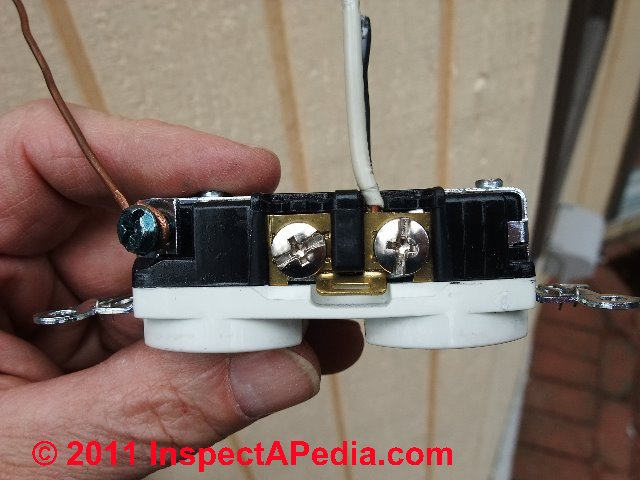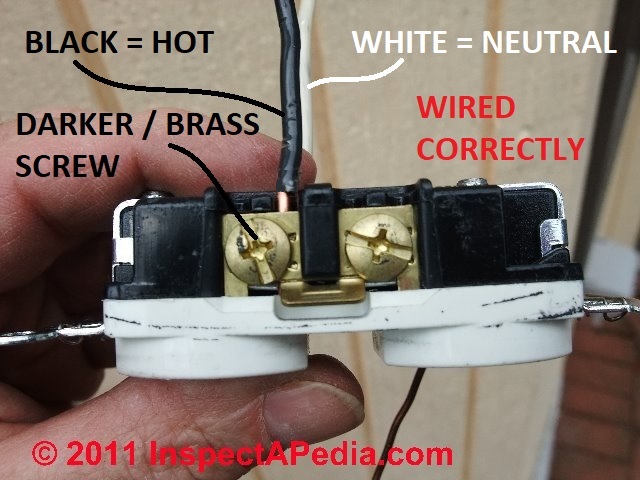
The bottom line is that reversed polarity at outlets is a shock hazard but electronic equipment plugged into an outlet with reversed polarity will still function. If an outlet is backstabbed it means that the neutral wires white and hot wires either red blue or yellow are pushed into small holes in the back of an outlet instead of being anchored down by screws.

Ive been redoing them but havent felt much urgency since the outlet works.
Will an outlet work if wired backwards. But heres the catch. If you connect the circuit wires to the wrong terminals on an outlet the outlet will still work but the polarity will be backward. When this happens a lamp for example will have its bulb socket sleeve energized rather than the little tab inside the.
If the white wire is connected to where the hot wire should be its wired backwards. If thats the case all he needs to do is switch the wires and everything will be fine and dandy. On the other hand if everything looks correct to the electrician the white wire is.
Im not sure its the same with all GFCI receptacles but I lived in an apartment that had the GFCI receptacle at the start of the run then two receptacles after it in the other two bathrooms. The GFCI was wired backwards as you describe and the result was no power at the other two outlets. Actually all electronic and electrical equipment will work with a 2 prong plug inserted backwards into the receptacle.
In the case of radios and television sets there may be a slight increase in interference from stray electrical fields you could say phantom voltage radiating into the air if the plug is inserted backwards. Wiring a receptacle backwards - hot wired to neutral and neutral wire to hot side of the receptacle - wont be obvious to users. Stuff plugged in will still work -.
Will an outlet work if wired backwards. But heres the catch. If you connect the circuit wires to the wrong terminals on an outlet the outlet will still work but the polarity will be backward.
Inside an outlets electrical box the black hot wire should be connected to the brass-colored terminal on. If the white wire is connected to the smaller slot on the outlet then the outlet was wired backwards. The fix is as simple as swapping the wires around on the outlet.
The most important device that wont work with a mis-wired outlet is a hot-side fuse or circuit breaker. If hot and neutral are reversed and something within the device shorts to ground none of the current will be flowing through the fuse or circuit breaker so it wont be able to provide any protection. Half the house was wired backwards and obviously the experienced guy didnt bother to check the flunkys work.
There was a distinct demarcation as to where the outlets were wired wrong. The flunky did the bedrooms and a bathroom and the other guy did all the more technical areas which were correct. Wiring reversals in.
When you back feed a breaker instead of the wires coming out of the breaker going to your circuits outlets the generator wiring is sending power into the breaker. If you look at the back panel of a load cente breaker panel you will see a buss bar flat bar with spikes sticking up. One may also ask what does it mean to backfeed a breaker.
Any 5 electrical tester will alert you to this condition assuming you have a properly grounded three-prong outlet. What happens if you wire a single pole switch backwards. But heres the catch.
If you connect the circuit wires to the wrong terminals on an outlet the outlet will still work but the polarity will be backward. If these connections are backward the polarity is wrong. What happens if you wire outlet backwards.
But heres the catch. If you connect the circuit wires to the wrong terminals on an outlet the outlet will still work but the polarity will be backward. When this happens a lamp for example will have its bulb socket sleeve energized rather than the little tab inside the socket.
Reversed polarity on an electrical outlet is dangerous. If you accidentally reverse these wires the device you plug in to the receptacle may work but it is unsafe and risks a short circuit shock or fire. Even a simple light or floor lamp is less safe with polarity reversed.
Simply swapping the wires at the outlet would not be an acceptable fix. The bottom line is that reversed polarity at outlets is a shock hazard but electronic equipment plugged into an outlet with reversed polarity will still function. Dont assume that your outlet is wired properly just because it works.
Polarized outlets and plugs ensure that electricity flows in one direction only. This makes things like lamps and many appliances more safe to operate. But heres the catch.
If you connect the circuit wires to the wrong terminals on an outlet the outlet will. But heres the catch. If you connect the circuit wires to the wrong terminals on an outlet the outlet will still work but the polarity will be backward.
When this happens a lamp for example will have its bulb socket sleeve energized rather than the little tab inside the socket. If an outlet is backstabbed it means that the neutral wires white and hot wires either red blue or yellow are pushed into small holes in the back of an outlet instead of being anchored down by screws. So why is that dangerous.
Well when wiring an electrical outlet you need to be sure that all wires are securely in place. The direction of incoming and outgoing wires of low-voltage circuit breakers cannot be reversed because the operating mechanism on the moving contact side and the static contact side of the circuit breaker has different dielectric properties and the arc roots on the moving and static terminals of the circuit breaker move in different ways. If the lower inlet line is used the circuit breaker.
Heres what happens when somebody wires a GFCI receptacle with the load and line wires reversed. The GFCI will work in the sense that you can plug in a hair dryer and the hair dryer will blow hot air. If the load and line wiring gets messed up a ground fault radio in the tub wont trip the GFCI.
I was suprised I didnt know that a GFI could be fed backwards and have power on the outlet plug-in terminals. The line wire terminals on the GFI werent energized hence the dead downstream receptacles. I found another GFI receptacle in his basement that was wired the same way.
I learned something new. Outlet Is Wired Backwards Conventional duplex electrical receptacles are connected to three electrical wires. A black hot wire a white neutral wire and a green ground wire.
As discussed above these three wires must be connected to the proper terminals on the receptacle. But heres the catch. If you connect the circuit wires to the wrong terminals on an outlet the outlet will still work but the polarity will be backward.
Older ones would still work but would not GFI protect the load conductors. What you are describing is one symptom of a bad. All my outlets are wired that way.
Ive been redoing them but havent felt much urgency since the outlet works. It is a simple task to correct except the house was built using 10 gage wire - - between the stiff wire my arthritis it is no fun.